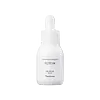What's inside
What's inside
 Key Ingredients
Key Ingredients

 Benefits
Benefits

 Concerns
Concerns

No concerns
 Ingredients Side-by-side
Ingredients Side-by-side

Water
Skin ConditioningPropanediol
SolventTrehalose
HumectantEctoin
Skin ConditioningHydrogenated Farnesene
EmollientPolyglyceryl-3 Distearate
EmulsifyingBetaine
HumectantCoco-Caprylate/Caprate
EmollientPanthenol
Skin ConditioningGlycerin
HumectantCetearyl Alcohol
EmollientPropylheptyl Caprylate
EmollientPrunus Amygdalus Dulcis Oil
Skin ConditioningHyaluronic Acid
HumectantHydrolyzed Hyaluronic Acid
HumectantSodium Hyaluronate
HumectantSodium Hyaluronate Crosspolymer
HumectantGlycine Soja Oil
EmollientInulin
Skin ConditioningCellulose
AbsorbentFructose
HumectantGlucose
HumectantHydrolyzed Glycosaminoglycans
HumectantTocopherol
AntioxidantTocopheryl Acetate
AntioxidantTetrasodium Glutamate Diacetate
Lactic Acid
BufferingGlyceryl Stearate Citrate
EmollientCellulose Gum
Emulsion StabilisingXanthan Gum
EmulsifyingEthylhexylglycerin
Skin ConditioningRaspberry Ketone
MaskingSodium Hydroxide
BufferingBenzyl Glycol
SolventPhenoxyethanol
PreservativeWater, Propanediol, Trehalose, Ectoin, Hydrogenated Farnesene, Polyglyceryl-3 Distearate, Betaine, Coco-Caprylate/Caprate, Panthenol, Glycerin, Cetearyl Alcohol, Propylheptyl Caprylate, Prunus Amygdalus Dulcis Oil, Hyaluronic Acid, Hydrolyzed Hyaluronic Acid, Sodium Hyaluronate, Sodium Hyaluronate Crosspolymer, Glycine Soja Oil, Inulin, Cellulose, Fructose, Glucose, Hydrolyzed Glycosaminoglycans, Tocopherol, Tocopheryl Acetate, Tetrasodium Glutamate Diacetate, Lactic Acid, Glyceryl Stearate Citrate, Cellulose Gum, Xanthan Gum, Ethylhexylglycerin, Raspberry Ketone, Sodium Hydroxide, Benzyl Glycol, Phenoxyethanol
 Reviews
Reviews

Ingredients Explained
These ingredients are found in both products.
Ingredients higher up in an ingredient list are typically present in a larger amount.
Ectoin is a compound found naturally in some species of bacteria. It can be synthetically created for skincare use.
This ingredient is an osmolyte; Osmolytes help organisms survive osmotic shock (it protects them from extreme conditions). It does this by influencing the properties of biological fluids within cells.
When applied to the skin, ectoin helps bind water molecules to protect our skin. The water forms a sort of armor for the parts of our skin cells, enzymes, proteins, and more.
Besides this, ectoin has many uses in skincare:
A study from 2004 found ectoin to counteract the damage from UV-A exposure at different cell levels. It has also been shown to protect skin against both UV-A, UV-B rays, infrared light, and visible light.
Studies show ectoin to have dual-action pollution protection: first, it protects our skin from further pollution damage. Second, it helps repair damage from pollution.
In fact, ectoin has been shown to help with:
Fun fact: In the EU, ectoin is used in inhalation medication as an anti-pollution ingredient.
Ectoin is a highly stable ingredient. It has a wide pH range of 1-9. Light, oxygen, and temperature do not affect this ingredient.
Learn more about EctoinEthylhexylglycerin (we can't pronounce this either) is commonly used as a preservative and skin softener. It is derived from glyceryl.
You might see Ethylhexylglycerin often paired with other preservatives such as phenoxyethanol. Ethylhexylglycerin has been found to increase the effectiveness of these other preservatives.
Glycerin is already naturally found in your skin. It helps moisturize and protect your skin.
A study from 2016 found glycerin to be more effective as a humectant than AHAs and hyaluronic acid.
As a humectant, it helps the skin stay hydrated by pulling moisture to your skin. The low molecular weight of glycerin allows it to pull moisture into the deeper layers of your skin.
Hydrated skin improves your skin barrier; Your skin barrier helps protect against irritants and bacteria.
Glycerin has also been found to have antimicrobial and antiviral properties. Due to these properties, glycerin is often used in wound and burn treatments.
In cosmetics, glycerin is usually derived from plants such as soybean or palm. However, it can also be sourced from animals, such as tallow or animal fat.
This ingredient is organic, colorless, odorless, and non-toxic.
Glycerin is the name for this ingredient in American English. British English uses Glycerol/Glycerine.
Learn more about GlycerinWater. It's the most common cosmetic ingredient of all. You'll usually see it at the top of ingredient lists, meaning that it makes up the largest part of the product.
So why is it so popular? Water most often acts as a solvent - this means that it helps dissolve other ingredients into the formulation.
You'll also recognize water as that liquid we all need to stay alive. If you see this, drink a glass of water. Stay hydrated!
Learn more about Water